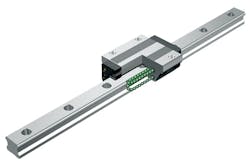When (and How) to Consider a Custom Linear Bearing
Each application is a little bit different. For every load that can be perfectly supported by a stock bearing, there are others that require a customized solution. A project may involve specialized environments, extreme performance demands, tight scheduling, and more. Let’s focus on some of the techniques engineers can use to achieve the system characteristics they want.
In some cases, the need for customization is obvious. Vacuum applications, for example, need special consideration for contamination control. In other cases, the need to move beyond stock products only becomes apparent after prototyping.
Most of the conversations that we have with people about customization occur when they’re developing a new product and building their first unit. They may have empirically discovered some undesirable characteristic in their system such as excess vibration or a structural element that leans enough to act as an overhung load. Modeling is important, but you can’t really guess what’s going to happen with a high degree of accuracy until you build the system.
Fortunately, there are many customization techniques that can be used to mitigate the most common problems. In this video, Greg Perez, strategic account manager at Motion Solutions, discusses how different options can improve system performance.
Designing for Vacuum
Clean-room and vacuum applications have very strict requirements for particulate control. Any time components are in motion, you run the risk of generating particles. Grease can minimize friction, and thus particulation, but many formulations outgas, which can compromise the vacuum. Clean-room greases are designed to address both of these issues.
Clean-room greases are formulated to have less dust generation, low outgassing properties, and features that reduce the chance of compromising the application. These greases are manufactured in a variety of grades. Particularly for demanding systems, choosing a clean-room grease requires careful consideration.
Also, the choice of grease is just the starting point. There are many other steps and factors that need to be addressed in a clean-room application beyond just the choice of grease itself. You need to take into account the preparation of the rail, how the bearing is going to be built and shipped from the manufacturer, whether it needs any burn-in or bake-out procedures, etc.
Clean-room greases have many useful characteristics. Their downside is that they tend to be gummy, creating more friction than their conventional counterparts. The solution is to look beyond the grease to the electromechanical design.
Optimizing the Preload
Preload is the force applied to an unloaded bearing to adjust the amount of clearance between the bearing element and the raceway. In a bearing incorporating balls or rollers, the preload is modified by changing the diameter of the rolling element. The amount of preload applied can be used to adjust the stiffness (and friction) of the bearing.
The larger the ball, the stiffer the system—and the converse is also true. In the clean-room application discussed above, for example, reducing preload by switching to smaller balls can compensate for the increased friction introduced by the clean-room grease.
Stock bearings arrive with a standard preload set at the factory. That does not mean design engineers don’t have options. To achieve the exact amount of preload necessary for the system, skilled technicians can swap out balls of 1 mm increments. The high degree of granularity in preload can be used to fine-tune performance.
A customer with a vertical application could use preload to, for example, increase friction in the system and reduce requirements for a holding brake. This could reduce size, cost, and inertia, which is important for highly dynamic applications like robotics. It could also lower power consumption in portable devices.
Alternatively, lowering preload friction in a horizontal application can reduce the power required to move the load from point-to-point, resulting in a more efficient system. A relatively small change at the bearing level can make a huge difference wherever your motion is occurring on that machine. Given the benefits, adding a custom preload to a bearing can be surprisingly economical.
Materials and Supply Chain Management
Material composition is another option when selecting a bearing. Often bearings are made from aluminum, steel, stainless steel, or ceramic to adapt to different applications and environments. Specialty coatings can be applied to the rails and blocks to protect against corrosion or provide different friction characteristics. Choice of coating can also affect availability, however. With the current growth in manufacturing, lead times on some linear bearings have extended to 12 months or more. Specialty coatings can increase lead times even further.
Machine builders and OEMs need to satisfy multiple conflicting requirements every time they design a system. Customizing bearings provides multiple methods for resolving these conflicts. To discover what’s possible, consult a bearing specialist with the infrastructure and extensive industry experience to deliver the performance you need.
Casey Covey is Northern California sales manager at Motion Solutions. Check out Motion Solutions for more information for your next project.

